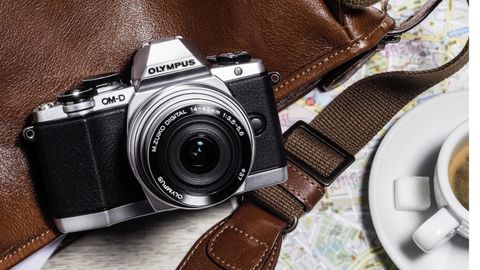Why you can trust TechRadar
Olympus has used a very similar design for the E-M10 as it has for the Olympus E-M5, the original OM-D. However, at 119.1x82.3x45.9mm and 350g it's a little bit smaller and lighter than the older camera (121x89.6x41.9mm and 373g). Consequently it's also smaller than the OM-D E-M1 (130.4x93.5x63.1mm and 443g), which sits at the top of the Olympus compact system camera line-up.
It doesn't have the dust- and splash-proofing of the E-M5, nor the freeze-proof build of the E-M1, but it is constructed from metal so it feels nice and solid.
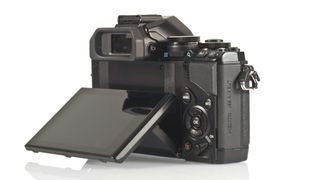
A small, but pronounced rubberised pad on the back of the E-M10 makes a good, comfortable thumbrest, while a ridge on the front provides grip for your fingers. The two combine to make the camera feel secure in your hand while shooting and when carrying it between shots.
The control layout of the E-M10 is almost identical to that of the E-M5, albeit on a slightly smaller body.
As before, there are plenty of button and dial controls giving a direct route to camera settings. Everything is within easy reach and the controls feel responsive.
Assured layout
Following the layout of the E-M5 rather than the E-M1 means that the E-M10 has a mode dial on the left side of the top-plate as you hold the camera for shooting. This provides a route to all the exposure modes. While there is the usual option for Art Filters, these can also be applied when shooting in the other exposure modes such as aperture priority, so it is possible to retain control over the camera's settings.
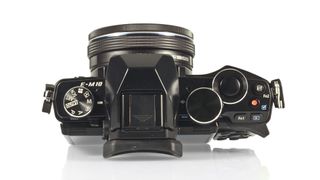
The two control dials on the top of the E-M10, for adjusting shutter speed/aperture and exposure compensation, are a little deeper and chunkier than the ones on the E-M5, but the difference is subtle.
Like the E-M5, the E-M10 has two Function buttons which can be customised to perform different operations. The button marked 'Fn2' button at the top of the camera also has the Highlights and Shadows icon as it gives direct access to this contrast control. However, it can also be used to access the Color Creator, sensitivity, white balance, Image Aspect and Magnify options.
Holding the Fn2 button down while rotating one of the control dials allows you to select the option (Color Creator, sensitivity, white balance, Images Aspect and Magnify) that you want. Once the button is released, a single press activates the feature, ready for adjustment or use.

The E-M10's 3-inch 1,370,000-dot screen provides a nice, clear view with plenty of detail visible even in quite bright conditions, but when the sun is shining the electronic viewfinder (EVF) is a welcome alternative. It's helpful that there's a sensor to detect when the camera is held to the eye.
This activates the EVF so you can quickly switch between the two viewing devices. However, if you want to dictate when you use one or the other, the sensor can be deactivated and there's a button on the side of the EVF.
Touchscreen
As usual, the touchscreen can be used to alter the focus point with a tap of a finger. It can also be used to trip the shutter, first focusing on the point you touch and then taking the shot. We found the touchscreen to be very responsive and quick to use, just as it is in the E-M5.
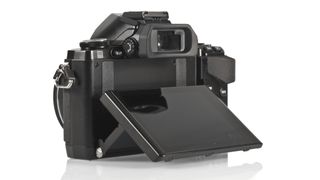
As it's mounted on a tilting mechanism the LCD screen is easier to see than a fixed screen when shooting landscape format images from low and high angles, but it's no help with portrait format images.
Olympus's reluctance to provide a fully articulating screen is somewhat counterbalanced by the fact that it's possible to compose images on a smartphone screen. This can be achieved while controlling the E-M10 remotely via the built-in Wi-Fi connectivity and Olympus Image Share app.
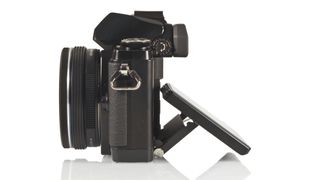
The 1,440,000-dot electronic viewfinder in the E-M10 is the same as the one in the E-M5, but it benefits from the Adaptive Brightness Technology found in the E-M1. This adjusts the brightness of the view according to the ambient light to give a more comfortable viewing experience, taking into account the size of the user's pupil.
We found that the EVF provides an excellent view with no obvious texture or flickering (it operates at 120fps). EVF naysayers should give it a try because it brings many benefits over an optical finder including the ability to see the image as it will be captured.
Kit lens
The new 14-42mm kit lens extends promptly when the camera starts up and it feels well-balanced on the E-M10. However, it takes a few moments to get used to how close the zoom ring is to the camera body. Also, anyone switching from an SLR may initially find their fingers naturally resting on the focus ring on the end of the barrel.
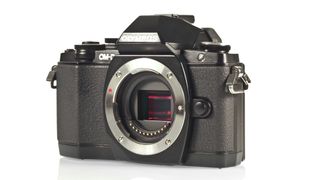
Connecting the E-M10 to a smartphone or tablet using the built-in Wi-Fi system is easy thanks to the free Olympus Images Share (OI Share) app. Although there's no NFC (Near Field Communication) chip, initial set-up is simplified by the fact that the camera's screen displays a QR code which the phone scans to obtain the necessary data.
From here it's just a question to touching Wi-Fi on the camera's screen to activate the system, waiting a couple of seconds and then starting OI Share before selecting the desired option in the app – Remote Control, Import Photos, Edit Photo or Add Geotag.
The camera responds quickly to settings adjustments made via the phone and the system provides a convenient method of controlling the camera when shooting from awkward angles or tight spots. The only downside is that the digital level isn't displayed on the phone screen, so you can't be sure that the horizon will be level in the image.
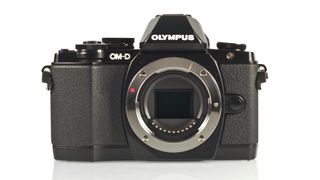
It's especially useful to control the camera remotely via the app when shooting in Live Bulb or Live Time mode, as it avoids introducing blur when you touch the camera. It's also often more comfortable to watch the image build up on the 'phone rather than the camera, and has the added benefit of drawing attention away from the camera.
